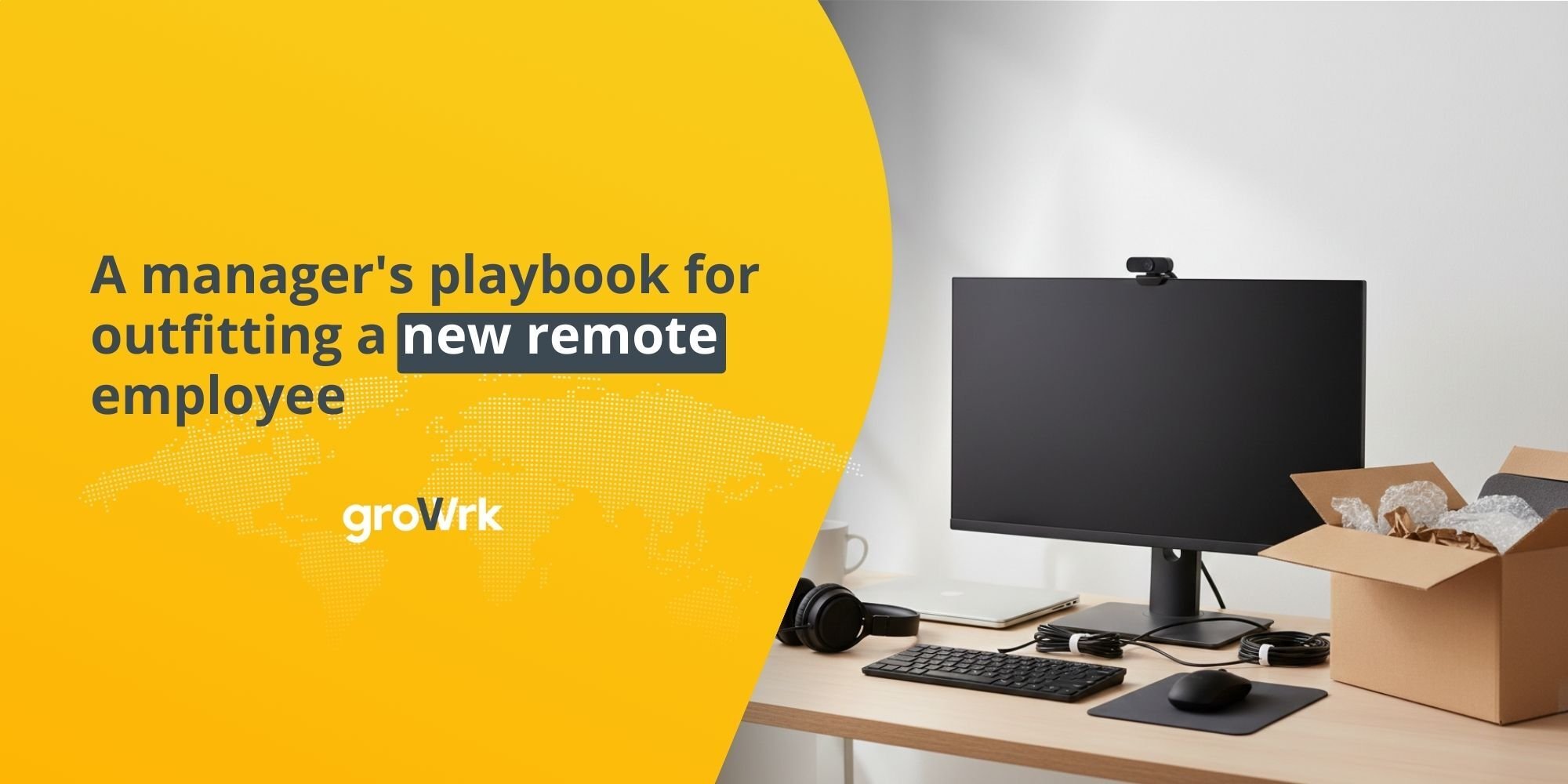Flexible Work Arrangements : Why More Companies Are Moving to It
 GroWrk Team
GroWrk Team
As many didn’t know about remote work until 2020, flexible work arrangements were also pretty low profile until the Coronavirus. They were usually limited to part-time positions or for working mothers.
As many organizations were forced to go remote, many have been converted to the benefits of allowing employees to choose when, where, and how they want to work. Things have even gone a step further by companies like Unilever and even countries like Spain implementing a 4-day workweek.
There are even companies reducing employee hours to 30 and still paying them the same! Crazy? We don’t think so.
If there is anything that remote work has taught us, empowering employees to complete their tasks without commuting or clocking in 8 hours every day has increased productivity, mental health, and physical well-being.
So, let’s dive into why companies are implementing more flexible work arrangements.

What are flexible work arrangements?
The term flexible work arrangements means letting employees choose their preferred working style. It includes:
- Scheduling and hours worked
- Remote work
- PTO policies
- Dress code
- Extended Leave
Flexible work arrangement examples

The employer is accommodating and empowering the employee to do their best work. You might have a combination of different work arrangements or just work flexibly 6 am-2 pm Monday, Tuesday so you can pick up your kids after football practice in the afternoons.
Scheduling your hours and days comes down to flextime, compressing the workweek, overtime pay and shifts, part-time work, and job sharing. As in the example above, this is great for parents and keeps women in the workforce.
A remote work arrangement is the choice to work from home or anywhere else. It is measured more on output-based (instead of time-based). At this point, over a quarter of the workforce wants to continue remote.
PTO or paid time off can be rather complex as well. There are unlimited, flexible, or floating PTO and vacation policies. These policies allow employees to take paid vacation days, personal days, or sick leave days at an employee's request (and in some cases, as much as they wish.)
The dress code at this point is getting to a non-issue in the workplace, but it will see a resurgence as people decide on the appropriate outfit to wear after months in quarantine. All jokes aside, the casual dress code of startups has seemed to have impacted most corporate environments.
Extended leave can be anything from maternity leave to a sabbatical. It really depends on what the company prioritizes as days employees should be compensated while not physically working. Many companies are now implementing paid mental health days for employees to recharge from stressful weeks.
What good do these policies or agreements bring to workers and company growth?
Why flexible work arrangements are good
According to research by Citrix, companies that have flexible work arrangements can save up to $20,000 per employee per year. It also increases productivity by 27%!

Some exciting trends develop When comparing two groups with flexible work schedules and ones without. In a recent study conducted by the American Sociological Review, employees who were randomly given an “experimental” schedule gave them lots of work flexibility fared better overall, both at work and at home.
The study concluded that workers with a flexible schedule slept better, felt healthier, and reported experiencing less stress. The research lasted three years, and the flex employees were much more interested in staying with the organization over the long term.
You even had Mark Zuckerberg announce that the flexibility allowed by remote work gave him more personal happiness and time to spend with his family. This was the primary motivator for Facebook to implement a fifty-fifty remote work model. 50% of the year remote, and 50% of the year in a hybrid work model.
Then you have the environmental benefits. If half the U.S. worked remotely for half the year, that would be the same as taking 10 million cars permanently off the road. In addition, energy costs for employers with flexible work arrangements decrease by 18%.
Why are some companies pushing back?
With all these benefits, why do some leaders and companies resist giving a flexible work schedule beyond the pandemic? Why are some companies like Apple requiring mandatory office days?

Some of it may be due to old-school thinking, where managers feel the need to monitor employees to ensure they are getting all their work done. Some people may have missed this level of control during the pandemic and feel that productivity has slipped only because they can’t see everything being done.
Another theory is the generational gap. HubSpot reports that 45% of millennials would choose workplace flexibility over pay any day of the week. If almost half of the millennials want it, GenZers are probably not far behind.
Once you move up to the baby boomer and Gen X generations, the demand begins to wane because flexible work has always been seen as a perk.
Many in this age range in upper management clamor to return to the normal they once knew and not waste the money they invested in office spaces.
This is more prevalent in older industries or companies, but significant gaps may emerge between rigid and flexible organizations as time goes on.
Why are more companies seeing the value of flexible work arrangements benefits?
To make it as evident as possible, here is a quote from someone on LinkedIn who recently joined a company that offers flexible working arrangements:
“On joining x company, I was excited to join a team known for its entrepreneurial spirit. I purposefully sought out a company where I knew I would feel empowered, motivated, and capable of driving projects end to end. I like the logistics management of fitting pieces of the puzzle together and coordinating with different people to accomplish a common goal. I love pulling a plan together and watching it be executed. Now that we’ve switched to remote work, I also enjoy having flexibility in my schedule. As a busy mom with two young children, even though I work a lot, I am able to arrange my time so that I can still pick my kids up from school, take them to their activities, and get dinner started.”

Companies realize that offering flexible work arrangements brings a positive brand perspective for prospective employees. This is the main driving force for growing companies that have been scaling fast during the pandemic and are highly optimistic about this year as re-openings accelerate.
It comes down to winning the war on talent as there are fewer people for highly skilled positions, and just in April this year, 4 million people quit their jobs. The pandemic gave people the ability to improve personally and professionally and now dare to pursue careers they are passionate about.
A great hiring restructuring is taking place, but the results have shown that the companies that innovate the most have three common factors:
- A gender and culturally diverse workforce
- A young talent pipeline with in-house training and advancement
- Highly motivated and engaged employees
Flexible work arrangements allow for a more gender-equal employment base by offering flexible schedules to both working mothers and working fathers. Generous PTO or maternity leave also helps in instilling a gender-inclusive brand image.
Flexible work options like telecommuting allow companies to recruit top talent from other countries while providing a more equitable working environment for minorities in their base of operations.
You are avoiding many of the micro-aggressions that can take place in an office environment and eliminating many of the preconceived biases in the recruitment process.
As we mentioned before, the younger generation ranks flexible work options as one of the main deciding factors for selecting a position.
In a study by Zenefits, they found that workers from 18-24 rate flexible work was as important to them as pay rate or health benefits (55%).
Therefore, these arrangements will be necessary for attracting young college graduates and having them stick with the company to improve their skills and grow.

Finally, in that same study, employees report being more motivated, having a better work-life balance, and being engaged when given flexible working options. This automatically translates to more productive employees and less likely to leave for another position.
When employees complete tasks rapidly and are committed to their organization’s growth, success is the logical conclusion.
Companies with flexible work arrangements
The Zenefits survey found that 71% of employees reported their company offering at least one flexible work arrangement even before the pandemic.
Some notable companies and industries that are offering a variety of flexible work options are:
- American Express's 50,000-strong global workforce offers contract, part-time, full-time, and remote work opportunities. Many positions also allow employees to work from home if they are parents, live a long distance from the office, or experience unexpected events.
- Automattic—The company has a popular work-from-anywhere policy and gave its employees a $250 wfh stipend at the start of the pandemic.
- Dell- Employees can work part of the year or all of the time remotely. 60% of its global workforce is now taking advantage of flexible work.
- UnitedHealth Group- Flexible and remote working is available to more than 25% of its new job openings.
Industries opening up to more flexible work arrangements
- Legal
- Manufacturing
- Healthcare
- Telecommunications
Flexible work arrangements policy
A great example of a flexible work arrangement policy is of the Australian company NBNCO. They offer over five different working arrangements to all of their employees.
Before requesting a flexible working option, employees have to consider how it might affect their current position. Once their manager approves it, they get placed in a three-week trial period.
If an employee’s work excels, they can stay in that arrangement for as long as they like. If their work begins to fall, they will have a meeting with their manager to discuss adjusting the arrangement.
Flexible work arrangements statistics
Right now, Flexjobs reports that 80% of companies offer both informal and formal flexible working arrangements. While USA Today reports, the figure is closer to 57% for formal flexible schedules.
Regardless, Bill gates said all the way back in 2019 that organizations that offer flexible working will always be on the edge of innovation.
Flexible work arrangements best practices and challenges

The best practice for implementing flexible work arrangements policies in your organization is to formalize everything. Keep an online record of the policy that everyone knows where it is and how to access it. This way, there is no confusion on what employees can or cannot do or ideas of preference.
There should also be training for managers on managing remote employees or those with flexible hours/ time zone differences.
If anyone is struggling with a specific flexible work program, the best course of action is to address the issue individually and not revoke the entire benefit. If there is no evidence of benefits, the policy should be revoked over time.
This way, you can avoid the many challenges that can occur with these arrangements, such as:
- Programs that aren’t relevant to workers' real needs and preferences.
- Creating a segment of workers that aren’t treated the same or have the same advancement opportunities as employees who work in the office or standard hours.
- Not communicating broadly enough the benefits of flexible scheduling and people thinking they may lose status if they take advantage of them.
Are you just starting to hire new employees with flexible work arrangements?
If you are onboarding new employees taking advantage of remote work or other flexible work arrangements, it can be a logistics nightmare to get them all the equipment they need.
That is why there exists a company like GroWrk. Their it asset management software has an intuitive dashboard for real-time insights into all the devices in your inventory. It is like an IT closet in the cloud where you can send employees equipment and pick it up with just a click of a button.
%204.26.29%20p.%20m..png?width=960&height=504&name=Captura%20de%20pantalla%202024-04-18%20a%20la(s)%204.26.29%20p.%20m..png)
Worried about security and compliance while working remotely? They got you covered with 24-hour help desk support, and all the devices you order come pre-installed with hardware-based VPNs and remote device management software.
As your company grows and you hire more international employees, GroWrk's ability to deliver to 150+ countries will keep you covered.
Grow remote with GroWrk. We provide and manage laptops, devices, other equipment and services to remote teams in over 150 countries.






